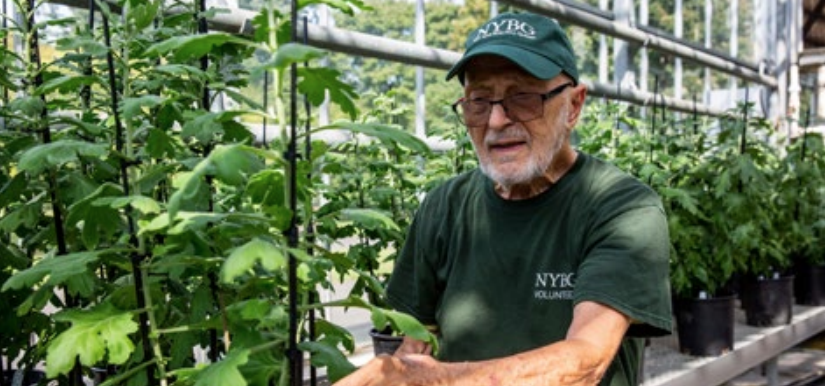Volunteer Profile: Robert Gallanty
Posted in Garden News on December 7 2018, by Plant Talk

Started: 2005
Lifetime Volunteer Hours: 6,088
How long have you been a NYBG volunteer and what was the inspiration for becoming one?
After retiring from the Navy, I moved from Norfolk, Virginia, to Riverdale, New York, and saw an advertisement in The Riverdale Press from The New York Botanical Garden. I had volunteered at botanical gardens before and wanted to volunteer again at another garden. After visiting the Garden and learning about the diverse opportunities for volunteering, from helping out in the Children’s Adventure Garden to giving tours for visitors, I decided to sign up for the program.
Did you have horticultural/gardening experience beforehand?
I was born and raised in the Puyallup Valley in Washington State where my grandparents had berry farms. My mother was very active in plant societies, including the local Chrysanthemum Society. Currently I also work in the gardens around the co-op that I live in and have been an amateur gardener for many years. I guess you could say that gardening is “in my blood.”
What is the most rewarding part of your work or a particular experience?
I really love to hear the wonderful feedback from the visitors who come to the Garden. After giving a tour, their responses are always enthusiastic about what they have seen and experienced during their visit. People are always excited and amazed telling me how much they have learned from the time we spend together and about the complexity of the work that goes into growing and exhibiting the plants.
What might surprise people about the work you do here?
As a tour guide and volunteer I have always loved to share the behind-the-scenes information on how complex the Horticulture program is at NYBG. What I call the “back story” includes so many interesting details about the history, staff, the amount of work and skill required to create the exhibitions or grow plants for displays, which surprises people the most. By teaching people about the things they do not see they gain a stronger appreciation for the work that goes into caring for the gardens and the plants. It is truly my hope that each visitor leaves NYBG with a greater appreciation for the site and the many hands and skills it takes to create the beautiful things the visitors love and come here to see.
Do you have a favorite plant/s in the Greenhouses?
Perhaps my favorite group to work with are the Japanese kiku. I really enjoy the detailed horticultural work that goes into the training and growing of these special chrysanthemums. The dedication and skill it takes to grow these plants according to the rigorous traditional methods shared with the staff by Japanese kiku masters is something that I find fascinating. Watching the plants grow and evolve and being part of that training process is very rewarding. After many hours of work, the real reward is sharing the beautiful flowers the public. Along with volunteering, I take many classes, have earned two Certificates, and am working on more. Taking classes helps me fill in the gaps in my knowledge and make me a more skilled volunteer in turn working with the plants helps me reaffirm what I have learned in my classes. The Adult Education program has taught me so much and helped me sharpen and expand my horticultural knowledge.
What is your favorite outdoor garden at NYBG?
Over the years I have volunteered at NYBG I have worked in many areas, from helping out in the Adventure Garden, giving tours in the Conservatory, and training plants at the Nolen Greenhouses. Each area has its particular merits. However, despite all those experiences I still think my favorite garden that I have worked in is the Peggy Rockefeller Rose Garden. Very few things can compare to the investment of work and the final reward of seeing it in full bloom.
This article originally appeared as part of a series on responsible citizenry in the 2018–2019 issue of Garden News, NYBG’s seasonal newsletter. For further reading, view the issue online and discover a sampling of stories about our current efforts and activities that promote, engage, and support active and responsible citizenry on local, regional, and global levels.

